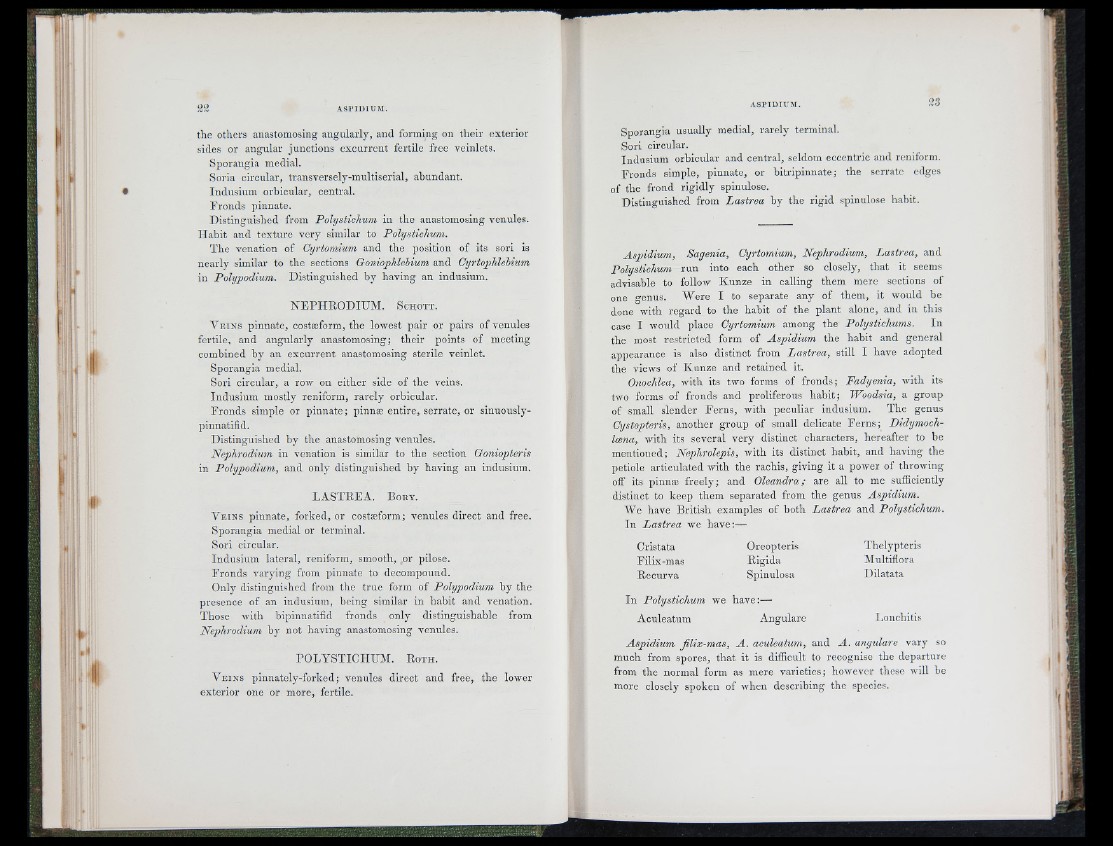
A S P ID IU M .
the others anastomosing angularly, and forming on their exterior
sides or angular junctions excurrent fertile free veinlets.
Sporangia medial.
Soria circular, transversely-multiserial, abundant.
Indusium orbicular, central.
Fronds pinnate.
Distinguished from Polystichum in the anastomosing venules.
Habit and texture very similar to Polystichum.
The venation of Cyrtomium and the position of its sori is
nearly similar to the sections Goniophlebium and Cyrtophlebium
in Polypodium. Distinguished by having an indusium.
N E FH EO D IUM . S c h o t t .
V e in s p in n a t e , c o s t» f o rm , t h e lo w e s t p a i r o r p a i r s o f v e n u l e s
f e r t i l e , a n d a n g u l a r l y a n a s to m o s in g ; t h e i r p o in t s o f m e e t in g
c o m b in e d b y a n e x c u r r e n t a n a s to m o s in g s t e r i l e v e in l e t .
Sporangia medial.
Sori circular, a row on either side of the veins.
Indusium mostly reniform, rarely orbicular.
Fronds simple or pinnate; pinn» entire, serrate, or sinuously-
pinnatifid.
Distinguished by the anastomosing venules.
Nephrodium i n v e n a t io n is s im i la r to t h e s e c t io n Ooniopteris
in Polypodium, a n d o n ly d i s t i n g u i s h e d b y h a v i n g a n in d u s iu m .
LASTREA. B o r y .
V e in s pinnate, forked, or cost»form; venules direct and free.
Sporangia medial or terminal.
Sori circular.
Indusium lateral, reniform, smooth, or pilose.
Fronds varying from pinnate to decompound.
Only distinguished from the true form of Polypodium by the
presence of an indusium, being similar in habit and venation.
Those with hipinnatlfid fronds only distinguishable from
Nephrodium by not having anastomosing venules.
PO LY ST ICHUM . R o t h .
V e in s pinnately-forked; venules direct and free, the lower
exterior one or more, fertile.
Sporangia usually medial, rarely terminal.
Sori circular.
Indusium orbicular and central, seldom eccentric and reniform.
Fronds simple, pinnate, or hitripinnate; the serrate edges
of the frond rigidly spinulose.
Distinguished from Lastrea by the rigid spinulose habit.
Aspidium, Sagenia, Cyrtomium, Nephrodium, Lastrea, and
Polystichum ru n into each other so closely, that it seems
advisable to follow Kunze in calling them mere sections of
one genus. Were I to separate any of them, it would be
done with regard to the habit of the plant alone, and in this
case I would place Cyrtomium among the Polystichums. In
the most restricted form of Aspidium the habit and general
appearance is also distinct from Lastrea, still I have adopted
the views of Kunze and retained it.
Onochlea, with its two forms of fronds; Fadyenia, with its
two forms of fronds and proliferous habit; Woodsia, a group
of small slender Ferns, with peculiar indusium. The genus
Cystopteris, another group of small delicate Ferns; Didymoch-
Icena, with its several very distinct characters, hereafter to be
mentioned; Nephrolepis, with its distinct habit, and having the
petiole articulated with the rachis, giving it a power of throwing
off its pinn» freely; and Oleandra; are all to me sufficiently
distinct to keep them separated from the genus Aspidium.
We have British examples of both Lastrea and Polystichum.
In Lastrea we have:—
Cristata
Filix-mas
Recurva
Oreopteris
Rigida
Spinulosa
In Polystichum we have:-—■
Aculeatum Angulare
Thelypteris
Multiflora
Dilatata
l.onchitis
Aspidium filix-mas, A . aculeatum, and A . angxdare vary so
much from spores, that it is difficult to recognise the departure
from the normal form as mere varieties; however these will be
more closely spoken of when describing the species.